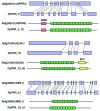Architecture of the PPR gene family in the moss Physcomitrella patens
- PMID: 23645116
- PMCID: PMC3858427
- DOI: 10.4161/rna.24772
Architecture of the PPR gene family in the moss Physcomitrella patens
Abstract
Pentatricopeptide repeat (PPR) proteins are widespread in eukaryotes and in particular, include several hundred members in land plants. The majority of PPR proteins are localized in mitochondria and plastids, where they play a crucial role in various aspects of RNA metabolism at the post-transcriptional level in gene expression. However, many of their functions remain to be characterized. In contrast to vascular plants, the moss Physcomitrella patens has only 105 PPR genes. This number may represent a minimum set of PPR proteins required for post-transcriptional regulation in plant organelles. Here, we review the overall structure of the P. patens PPR gene family and the current status of the functional characterization of moss PPR proteins.
Keywords: DYW domain; PPR protein; Physcomitrella patens; RNA cleavage; RNA editing; RNA splicing; homologous recombination; moss; targeted gene disruption.
Figures


Similar articles
-
A DYW-protein knockout in Physcomitrella affects two closely spaced mitochondrial editing sites and causes a severe developmental phenotype.Plant J. 2013 Nov;76(3):420-32. doi: 10.1111/tpj.12304. Epub 2013 Sep 10. Plant J. 2013. PMID: 23909746
-
One C-to-U RNA Editing Site and Two Independently Evolved Editing Factors: Testing Reciprocal Complementation with DYW-Type PPR Proteins from the Moss Physcomitrium (Physcomitrella) patens and the Flowering Plants Macadamia integrifolia and Arabidopsis.Plant Cell. 2020 Sep;32(9):2997-3018. doi: 10.1105/tpc.20.00311. Epub 2020 Jul 2. Plant Cell. 2020. PMID: 32616665 Free PMC article.
-
Two DYW subclass PPR proteins are involved in RNA editing of ccmFc and atp9 transcripts in the moss Physcomitrella patens: first complete set of PPR editing factors in plant mitochondria.Plant Cell Physiol. 2013 Nov;54(11):1907-16. doi: 10.1093/pcp/pct132. Epub 2013 Sep 20. Plant Cell Physiol. 2013. PMID: 24058147
-
An Overview of Pentatricopeptide Repeat (PPR) Proteins in the Moss Physcomitrium patens and Their Role in Organellar Gene Expression.Plants (Basel). 2022 Aug 31;11(17):2279. doi: 10.3390/plants11172279. Plants (Basel). 2022. PMID: 36079663 Free PMC article. Review.
-
Pentatricopeptide repeat proteins: a socket set for organelle gene expression.Trends Plant Sci. 2008 Dec;13(12):663-70. doi: 10.1016/j.tplants.2008.10.001. Epub 2008 Nov 12. Trends Plant Sci. 2008. PMID: 19004664 Review.
Cited by
-
Moss PPR-SMR protein PpPPR_64 influences the expression of a psaA-psaB-rps14 gene cluster and processing of the 23S-4.5S rRNA precursor in chloroplasts.Plant Mol Biol. 2021 Nov;107(4-5):417-429. doi: 10.1007/s11103-020-01090-z. Epub 2020 Oct 31. Plant Mol Biol. 2021. PMID: 33128724
-
Genome-wide analysis of the rice PPR gene family and their expression profiles under different stress treatments.BMC Genomics. 2018 Oct 1;19(1):720. doi: 10.1186/s12864-018-5088-9. BMC Genomics. 2018. PMID: 30285603 Free PMC article.
-
Genome-wide investigation and expression analyses of the pentatricopeptide repeat protein gene family in foxtail millet.BMC Genomics. 2016 Oct 28;17(1):840. doi: 10.1186/s12864-016-3184-2. BMC Genomics. 2016. PMID: 27793078 Free PMC article.
-
Molecular characterization of three PRORP proteins in the moss Physcomitrella patens: nuclear PRORP protein is not essential for moss viability.PLoS One. 2014 Oct 1;9(10):e108962. doi: 10.1371/journal.pone.0108962. eCollection 2014. PLoS One. 2014. PMID: 25272157 Free PMC article.
-
Potential of Transcript Editing Across Mitogenomes of Early Land Plants Shows Novel and Familiar Trends.Int J Mol Sci. 2019 Jun 18;20(12):2963. doi: 10.3390/ijms20122963. Int J Mol Sci. 2019. PMID: 31216623 Free PMC article.
References
-
- Gutmann B, Gobert A, Giegé P. Mitochondrial genome evolution and the emergence of PPR proteins. Adv Bot Res. 2012;63:253–313. doi: 10.1016/B978-0-12-394279-1.00010-7. - DOI
Publication types
MeSH terms
Substances
LinkOut - more resources
Full Text Sources
Other Literature Sources
